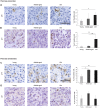Survey of senescent cell markers with age in human tissues
- PMID: 32160592
- PMCID: PMC7093180
- DOI: 10.18632/aging.102903
Survey of senescent cell markers with age in human tissues
Abstract
Cellular senescence, triggered by sublethal damage, is characterized by indefinite growth arrest, altered gene expression patterns, and a senescence-associated secretory phenotype. While the accumulation of senescent cells during aging decreases tissue function and promotes many age-related diseases, at present there is no universal marker to detect senescent cells in tissues. Cyclin-dependent kinase inhibitors 2A (p16/CDKN2A) and 1A (p21/CDKN1A) can identify senescent cells, but few studies have examined the numbers of cells expressing these markers in different organs as a function of age. Here, we investigated systematically p16- and p21-positive cells in tissue arrays designed to include normal organs from persons across a broad spectrum of ages. Increased numbers of p21-positive and p16-positive cells with donor age were found in skin (epidermis), pancreas, and kidney, while p16-expressing cells increased in brain cortex, liver, spleen and intestine (colon), and p21-expressing cells increased in skin (dermis). The numbers of cells expressing p16 or p21 in lung did not change with age, and muscle did not appear to have p21- or p16-positive cells. In summary, different organs display different levels of the senescent proteins p16 and p21 as a function of age across the human life span.
Keywords: aging; p16; p21; senescence in tissues.
Conflict of interest statement
Figures









References
Publication types
MeSH terms
Substances
LinkOut - more resources
Full Text Sources
Other Literature Sources
Medical
Miscellaneous

